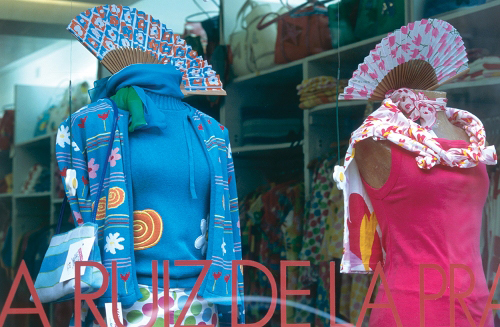Plaza Dos de Mayo On
2 May 1976 a young couple climbed on to the statue of Daoíz and Velarde
and performed a striptease in front of a boisterous crowd of youngsters
celebrating on the square. This was one of the first manifestations of
the movida (scene), a period of hedonism, enthusiasm and creative energy. Pedro Almodóvar The controversial Academy Award-winning film director shot his first movie, Pepi, Luci, Bom
in 1980. Iconoclastic and subversive, his bizarre characters –
drugpushing nuns, pill-popping housewives and outrageous transvestites –
shocked a society that was only just emerging from the Franco era and
captured the spirit of the movida on celluloid. Ceesepe This self-taught artist (real name Carlos Sánchez Pérez) was a leading figure of the movida.
He produced posters for several of Almodóvar’s films, as well as book
illustrations, cartoons and record covers. His exhibition, the “Last
Supper”, in the Moriarty Gallery in 1983, brought him to the attention
of a wider public. Ouka Lele Madrid-born
photographer Ouka Lele (real name Bárbara Allende) got her big break in
1984 when her work was shown at the Moriarty Gallery. She is now one of
Spain’s most famous photographers. Moriarty Gallery Lola
Moriarty’s art gallery in Calle Almirante (still going strong) was
enormously influential in promoting the careers of artists and
photographers of the movida. Her husband, Borja Casani, was editor of Luna,
a monthly magazine which published stories by Almodóvar and others. In
1984 Casani hired the entire Hotel Palace for a party attended by
several thousand movidistas. Mecano One of Spain’s best known pop bands of the movida
was formed by brothers José and Nacho Cano, and singer Ana Torroja.
They hit the big time after persuading a Madrid radio station to play
their first single. Rock Ola This La Latina nightclub was one of the most important venues of the movida period. Regularly closed down by the police because of drug dealing, it was here that all the influential movida bands played. Enrique Tierno Galván This
former Professor of Marxist philosophy was elected Mayor of Madrid in
1979 and it was his tolerant and relaxed approach that made the movida possible. One million people attended his funeral in 1986. Fashion Designers The movida
spawned a new generation of fashion designers who were all to become
international names. Jesús del Pozo, Adolfo Domínguez and Ágatha Ruíz de
la Prada all flouted the fashion conventions of the day.

Luís Antonio de Villena Villena’s novel Madrid ha muerto (Madrid has died), published in 1999, points out the scene’s darker side, as youthful hopes and ideals give way to disillusionment.
Top 10 Moments of La Movida
Death of General Franco The dictator’s death in 1975 marked the end of more than 35 years of authoritarian rule. Striptease This impromptu act in 1976 on Plaza Dos de Mayo reflected a new rebellious spirit in the capital. Enrique Tierno Galván The liberal minded mayor was elected in 1979. Pedro Almodóvar The film director released his first full length film, Pepi, Luci, Bom, y otras chicas de Montón in 1980. Ágatha Ruíz de la Prada The innovative fashion designer showed her collection in Madrid in 1981. Luna In 1982 this flagship magazine of the movida first appeared, and the city held its first carnival since Franco. El Travelling In 1983 this bar opened on Calle del Olivar and joined Rock Ola and El Sol as an important movida venue. Ouka Lele The photographer staged her first show at the Moriarty Gallery in 1984. Law of Desire Almodóvar’s
1986 film explored obsessive homosexual love and starred the young
actor Antonio Banderas. It is Spain’s top-grossing film. End of La Movida In 1991 the socialists lost power in Madrid, a sign that the social climate was turning against the movida.
|